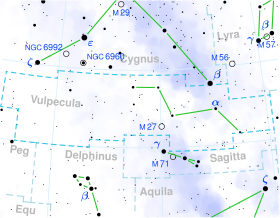Binary star system in the constellation Vulpecula
29 Vulpeculae is a suspected astrometric binary star system in the northern constellation Vulpecula . It is visible to the naked eye as a faint, white-hued point of light with an apparent visual magnitude of 4.82. The system lies approximately 209 light years away from the Sun based on parallax , and is a member of the IC 2391 supercluster . It is moving closer to the Earth with a heliocentric radial velocity of −17 km/s.
Radial velocity measurements from High Accuracy Radial Velocity Planet Searcher with an amplitude of 4 km/s indicate that it is a spectroscopic binary of unknown period. The visible component is an A-type main-sequence star with a stellar classification of A0V, and has some slight abundance anomalies that resemble a weak Am star . It is catalogued as a shell star , showing spectral features of a cooler circumstellar jacket of gas, and may be a proto-shell star. The star is an estimated 254 million years old with a relatively low projected rotational velocity of 52 km/s. It has 2.67 times the mass of the Sun and is radiating 71 times the Sun's luminosity from its photosphere at an effective temperature of 10,507 K.
References
^ Brown, A. G. A. ; et al. (Gaia collaboration) (August 2018). "Gaia Data Release 2: Summary of the contents and survey properties" . Astronomy & Astrophysics 616 . A1. arXiv :1804.09365 . Bibcode :2018A&A...616A...1G . doi :10.1051/0004-6361/201833051 .Gaia DR2 record for this source at VizieR .
^ Ducati, J. R. (2002). "VizieR Online Data Catalog: Catalogue of Stellar Photometry in Johnson's 11-color system". CDS/ADC Collection of Electronic Catalogues . 2237 . Bibcode :2002yCat.2237....0D .
^ Zorec, J.; Royer, F. (2012). "Rotational velocities of A-type stars". Astronomy & Astrophysics . 537 : A120. arXiv :1201.2052 . Bibcode :2012A&A...537A.120Z . doi :10.1051/0004-6361/201117691 . S2CID 55586789 . Vizier catalog entry
^ Gontcharov, G. A. (2006). "Pulkovo Compilation of Radial Velocities for 35 495 Hipparcos stars in a common system". Astronomy Letters . 32 (11): 759–771. arXiv :1606.08053 . Bibcode :2006AstL...32..759G . doi :10.1134/S1063773706110065 . S2CID 119231169 .
^ Anderson, E.; Francis, Ch. (2012). "XHIP: An extended hipparcos compilation". Astronomy Letters . 38 (5): 331. arXiv :1108.4971 . Bibcode :2012AstL...38..331A . doi :10.1134/S1063773712050015 . S2CID 119257644 . Vizier catalog entry
^ David, Trevor J.; Hillenbrand, Lynne A. (2015). "The Ages of Early-Type Stars: Strömgren Photometric Methods Calibrated, Validated, Tested, and Applied to Hosts and Prospective Hosts of Directly Imaged Exoplanets". The Astrophysical Journal . 804 (2): 146. arXiv :1501.03154 . Bibcode :2015ApJ...804..146D . doi :10.1088/0004-637X/804/2/146 . S2CID 33401607 . Vizier catalog entry
"29 Vul" . SIMBAD Centre de données astronomiques de Strasbourg . Retrieved 2019-03-17.Eggen, Olin J. (December 1995), "Reality Tests of Superclusters in the Young Disk Population", Astronomical Journal , 110 : 2862, Bibcode :1995AJ....110.2862E , doi :10.1086/117734 .
Borgniet, S.; Lagrange, A.-M.; Meunier, N.; Galland, F. (2017). "Extrasolar planets and brown dwarfs around AF-type stars". Astronomy and Astrophysics . 599 . A57. arXiv :1608.08257 . Bibcode :2017A&A...599A..57B . doi :10.1051/0004-6361/201628805 . S2CID 118723455 .
^ Adelman, Saul J.; Albayrak, Berahitdin (October 1998). "Elemental abundance analyses with DAO spectrograms - XX. The early A stars epsilon Serpentis, 29 Vulpeculae and sigma Aquarii" . Monthly Notices of the Royal Astronomical Society . 300 (2): 359–372. Bibcode :1998MNRAS.300..359A . doi :10.1046/j.1365-8711.1998.01859.x .
Hauck, B.; Jaschek, C. (February 2000). "A-shell stars in the Geneva system". Astronomy and Astrophysics . 354 : 157–162. Bibcode :2000A&A...354..157H .
Categories :
Text is available under the Creative Commons Attribution-ShareAlike License. Additional terms may apply.
**DISCLAIMER** We are not affiliated with Wikipedia, and Cloudflare.
The information presented on this site is for general informational purposes only and does not constitute medical advice.
You should always have a personal consultation with a healthcare professional before making changes to your diet, medication, or exercise routine.
AI helps with the correspondence in our chat.
We participate in an affiliate program. If you buy something through a link, we may earn a commission 💕
↑
